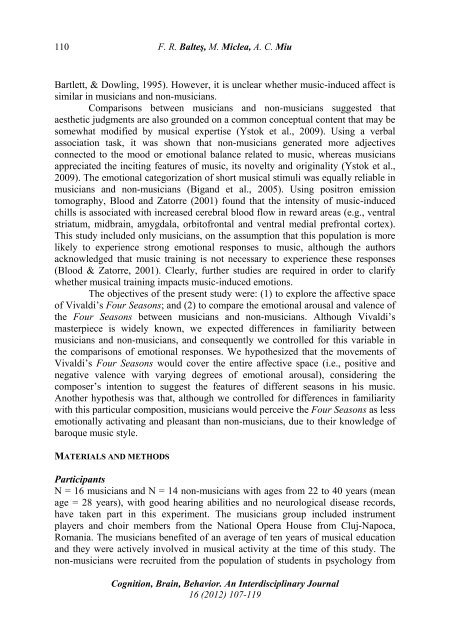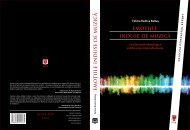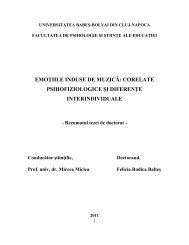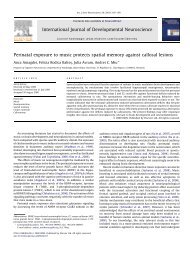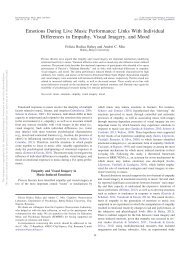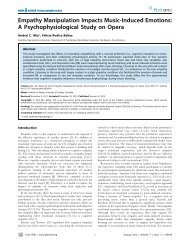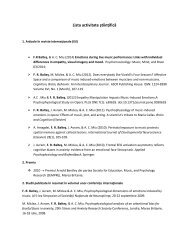o_19k6fnuqsqg41mt7rqp1c8pkueo.pdf
You also want an ePaper? Increase the reach of your titles
YUMPU automatically turns print PDFs into web optimized ePapers that Google loves.
110<br />
F. R. Balteş, M. Miclea, A. C. Miu<br />
Bartlett, & Dowling, 1995). However, it is unclear whether music-induced affect is<br />
similar in musicians and non-musicians.<br />
Comparisons between musicians and non-musicians suggested that<br />
aesthetic judgments are also grounded on a common conceptual content that may be<br />
somewhat modified by musical expertise (Ystok et al., 2009). Using a verbal<br />
association task, it was shown that non-musicians generated more adjectives<br />
connected to the mood or emotional balance related to music, whereas musicians<br />
appreciated the inciting features of music, its novelty and originality (Ystok et al.,<br />
2009). The emotional categorization of short musical stimuli was equally reliable in<br />
musicians and non-musicians (Bigand et al., 2005). Using positron emission<br />
tomography, Blood and Zatorre (2001) found that the intensity of music-induced<br />
chills is associated with increased cerebral blood flow in reward areas (e.g., ventral<br />
striatum, midbrain, amygdala, orbitofrontal and ventral medial prefrontal cortex).<br />
This study included only musicians, on the assumption that this population is more<br />
likely to experience strong emotional responses to music, although the authors<br />
acknowledged that music training is not necessary to experience these responses<br />
(Blood & Zatorre, 2001). Clearly, further studies are required in order to clarify<br />
whether musical training impacts music-induced emotions.<br />
The objectives of the present study were: (1) to explore the affective space<br />
of Vivaldi’s Four Seasons; and (2) to compare the emotional arousal and valence of<br />
the Four Seasons between musicians and non-musicians. Although Vivaldi’s<br />
masterpiece is widely known, we expected differences in familiarity between<br />
musicians and non-musicians, and consequently we controlled for this variable in<br />
the comparisons of emotional responses. We hypothesized that the movements of<br />
Vivaldi’s Four Seasons would cover the entire affective space (i.e., positive and<br />
negative valence with varying degrees of emotional arousal), considering the<br />
composer’s intention to suggest the features of different seasons in his music.<br />
Another hypothesis was that, although we controlled for differences in familiarity<br />
with this particular composition, musicians would perceive the Four Seasons as less<br />
emotionally activating and pleasant than non-musicians, due to their knowledge of<br />
baroque music style.<br />
MATERIALS AND METHODS<br />
Participants<br />
N = 16 musicians and N = 14 non-musicians with ages from 22 to 40 years (mean<br />
age = 28 years), with good hearing abilities and no neurological disease records,<br />
have taken part in this experiment. The musicians group included instrument<br />
players and choir members from the National Opera House from Cluj-Napoca,<br />
Romania. The musicians benefited of an average of ten years of musical education<br />
and they were actively involved in musical activity at the time of this study. The<br />
non-musicians were recruited from the population of students in psychology from<br />
Cognition, Brain, Behavior. An Interdisciplinary Journal<br />
16 (2012) 107-119


